
Studying of Diffusion of the Titan in Corundum Ceramics
Copyright © 2011 SciRes. MSA
949
4. Summary
Thus, in the present work results of high-temperature
diffusion Ti from TiB2 in a surface pure corundum ce-
ramics for the first time are shown:
1) depending on a temperature mode it is formed dif-
fusions a layer with various depth (to 500 µm - 3 mm) in
which some zones differ;
2) at transition from a surface deep into the sample,
maintenance Ti in zones decreases with ~0.4 to 0.00% wt.
(It is established with the help visible cathodelumines-
cence);
3) also can be defined and depth of penetration Ti in a
surface of grains of sapphire in the form of ion Ti+3 (it is
maximum to 20 µm, CL);
4) Knoop microhardness after thermodiffusion in-
creases more, than in 1.5 times.
Samples with coverings have shown increase in
strength at a bend on from 11.5% to 45% [4] in compari-
son with initial samples.
In summary it is possible to notice that there are real
prospects of improvement of physicomechanical proper-
ties of a surface of ceramics for the account of ceramic
coverings with the improved properties.
5. Acknowledgements
Authors consider as the pleasant debt to express gratitude
to doctors M. V. Zamoryanskaya, E. V. Ivanova, and V.
M. Krymov for the help in work.
REFERENCES
[1] “Materials Technology of Refractory Compounds: Achie-
vements and Problems,” Proceedings of Grigorij V. Sam-
sonov Member, Internal Conferences, Frantsevich Insti-
tute for Problems of Materials Science of National
Academy of Sciences of Ukraine, Kiev, Ukraine, 27-29
May 2008, 224 Pages (in Russian).
[2] G. V. Kalinnikov, R. A. Andrievsky, V. N. Kopylov and
D. Louzguine, “Properties Nanostructural and Amor-
phous Films of System TiB2-B4C,” Physics of the Solid
State, Vol. 50, No. 2, 2008, pp. 360-363 (in Russian).
[3] I. A. Podchernjaeva, “Structure and Properties of Com-
posite Electrospark, Laser and Magnetron Deposited AlN
–TiB2 Coatings,” Powder Metallurgy and Metal Ceram-
ics, Vol. 40, No. 9-10, 2001, pp. 501-508. (in Russian).
[4] V. N. Gurin, A. B. Sinani, L. I. Derkachenko, V. A.
Trunov, G. P. Zajtsev and V. M. Krymov, “Some Ways
of Hardening of a Surface Corundum Ceramics,” Refrac-
tories and Industrial Ceramics, No. 8, 2008, pp. 47-53.
(in Russian).
[5] V. S. Kortov, I. I. Milman, S. V. Nikiforov and V. E.
Pelenev, “The Mechanism of a Luminescence of the
F-Centers in Anion-Defective Single Crystals Aluminum
Ocsid,” Physics of the Solid State, Vol. 45, No. 7, 2003,
pp. 1202-1208. (in Russian).
[6] A. V. Puyats, M. J. Springis and J. A. Valbis, “On the
Nature of the Violet Luminescence in Quenche α-Al2O3
Single Crystals,” Physica Status Solidi (A), Vol. 62, 1980,
pp. 85-87. doi:10.1002/pssa.2210620162
[7] M. J. Springis and J. A. Valbis, “Visible Luminescence of
Colour Centres in Sapphire,” Physica Status Solidi (B),
Vol. 123, 1984, pp. 335-343.
doi:10.1002/pssb.2221230136